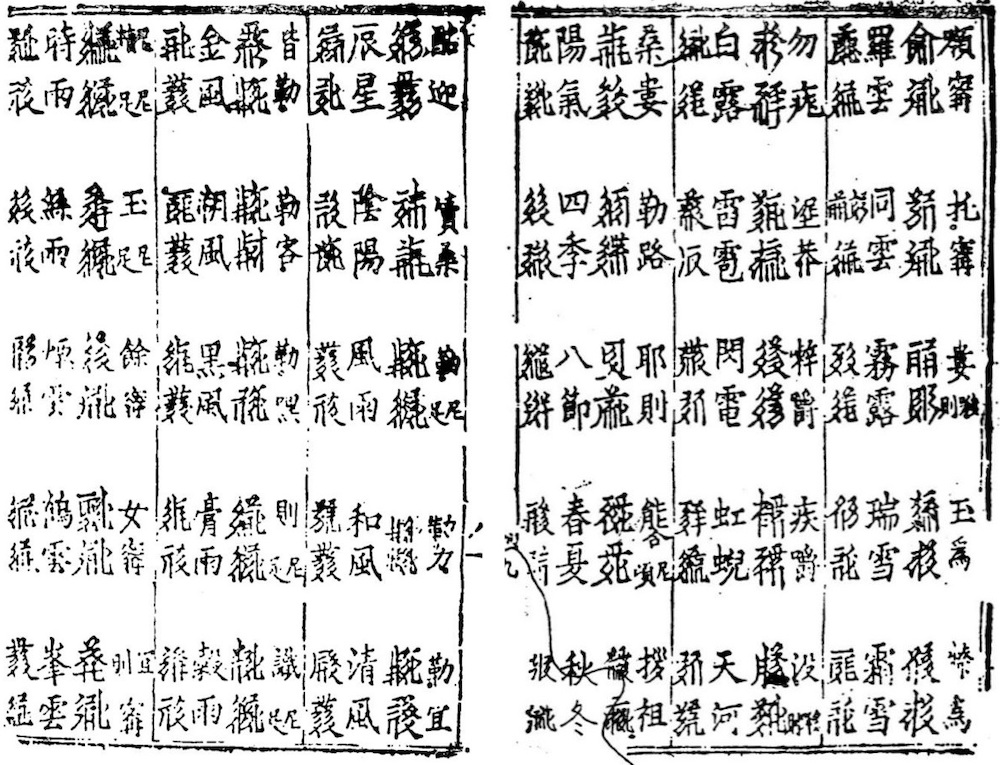Jul 17, 2010 © Ulrich Theobald
Fan-Han heshi zhangzhong zhu 番漢合時掌中珠 "Simultaneous Tangut-Chinese pearls-in-the-hand" is a Tangut-Chinese dictionary written by a person transliterated as "Gule Maocai 骨勒茂才", a Tangutan historian at the court of emperor Renzong 西夏仁宗 (r. 1140-1193) of the Western Xia empire 西夏 (1038-1227).
The dictionary was finished in 1190, but went lost with the conquest of the Western Xia empire by the Mongols. It was discovered in the ruins of Kara-Khoto (Heishui 黑水城 or Heicheng 黑城, today in Ejen Banner 額濟納旗, Alaša League 阿拉善盟, in Inner Mongolia) in 1909 by Pyotr K. Kozlov (1863-1935). The copy he found is a woodblock print of 37 pages in butterfly-binding. There is a preface in two languages, once in Tangutan, and once in Chinese, stressing the importance to learn two languages to administer an empire governed by a Tangut dynasty and inhabited by Chinese subjects.
Each word in the dictionary is, if in Tangutan language, transcribed with Chinese characters, and, on the Chinese side, transcribed with Tangutan script. The dictionary is arranged according to encyclopaedic spheres and can therefore rather be called a glossary than a real dictionary. The parts are: heaven; stars and planets; nature; earth; rivers and mountains; minerals, plants and animals; humans; the human body; and human activities. The last chapter covers almost half of the book and includes terms of kinship, Buddhism, architecture, tools and instruments of daily use, clothing and adornments, agricultural tools, terms of administration and politics and law, musical instruments, food, equestrian implements, terms of matrimonial ceremonies, etc.
The Fan-Han dictionary was first printed as a facsimile in the Soviet Union, and the first Chinese edition was published by Luo Fucheng 羅福成 (1885-1960) in 1924. A modern fascimile dates from 1989, published by the Ningxia Renmin Press 寧夏人民出版社.
Figure 1. Part of the Fan-Han heshi zhangzhong zhu
 |
Part of the Fan-Han heshi zhangzhong zhu, presenting the Chinese and corresponding Tangutan words of meteorological phenomena. Each page is divided into three panels with two columns (the latter without dividing line). From Gule Maocai and Huang (1989). Click to enlarge. |
Sources:
Cao Shujing 曹述敬, ed. (1991). Yinyunxue cidian 音韻學辭典 (Changsha: Hunan chubanshe), 37.
Gao Wende 高文德, ed. (1995). Zhongguo shaoshu minzu shi da cidian 中國少數民族史大辭典 (Changchun: Jilin jiaoyu chubanshe), 2265.
Gule Maocai 骨勒茂才, comp.; Huang Zhenhua 黃振華 et al., ed. (1989). Fan-Han heshi zhangzhong zhu (Yinchuan: Ningxia renmin chubanshe), 18-19.
Иванов, Алексей Иванович (1909). "Тангутские рукописи из Хара-хото / Из находок П. К. Козлова в г. Хара-хото. I.", Известия Императорского Русского Географического Общества, издаваемые под редакцией Секретаря Общества А. А. Достоевского, Том XLV, 463-470.
Jing Yongshi 景永時 (2013). "Fan-Han heshi zhangzhong zhu E cang bianhao neirong fuyuan yu banben kaozheng 番漢合時掌中珠》俄藏編號内容復原與版本考證", Ningxia shehui kexue 寧夏社會科學, 2013 (11).
Nie Hongyin 聶鴻音 (1987). "Fan-Han heshi zhangzhong zhu zhuyin fuhao yanjiu 《番漢合時掌中珠》注音符號研究", Yuyan yanjiu 語言研究, 1987 (11).
Shi Jinbo 史金波 (1992). "Fan-Han heshi zhangzhong zhu 番漢合時掌中珠", in Zhongguo da baike quanshu 中國大百科全書, Zhongguo lishi 中國歷史 (Beijing/Shanghai: Zhongguo da baike quanshu chubanshe), Vol. 1, 207.
Shi Jinbo 史金波 (1989). "Fan-hHan heshi zhangzhong zhu 番漢合時掌中珠", in Zhongguo da baike quanshu 中國大百科全書, Vol. Minzu 民族 (Beijing/Shanghai: Zhongguo da baike quanshu chubanshe)117.
Shi Jinbo 史金波 (1992). "Fan-Han heshi zhangzhong shu 番漢合時掌中珠", in Zhongguo da baike quanshu 中國大百科全書, Vo. Yuyan wenzi 語言文字 (Beijing/Shanghai: Zhongguo da baike quanshu chubanshe)68.
Zhou Weizhou 周偉洲, Ding Jingtai 丁景泰, ed. (2006). Sichou zhi lu da cidian 絲綢之路大辭典 (Xi'an: Shaanxi renmin chubanshe), 770.